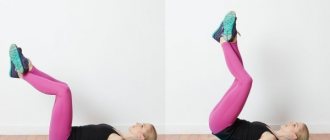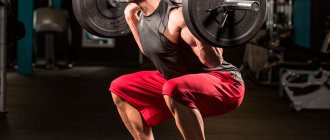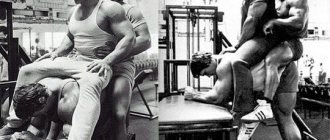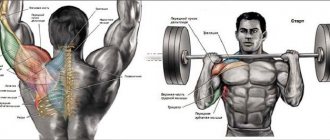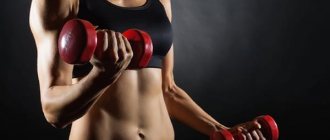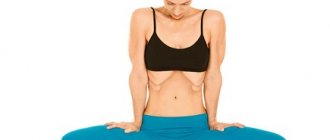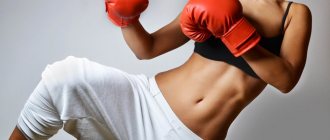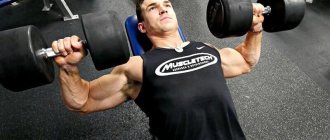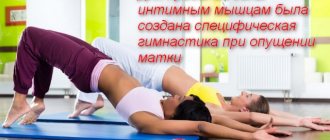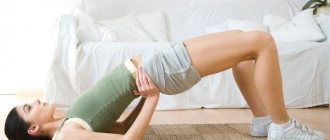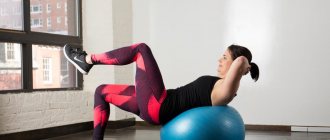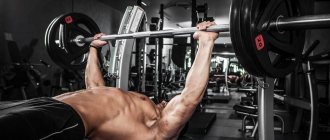Dumbbell curls have a bad reputation. They expand the waist, which is why all fitness trainers are up in arms about them and do not recommend doing them. But they are still used in bodybuilding and strength sports to this day. Why is that? It's simple - this exercise helps strengthen the core, make it more rigid, and protect the person lifting the barbell from spinal injuries. Bend-overs are technically simple, help develop the oblique muscles, and the expansion of the waist is usually offset by the growth of other muscle groups.
Execution technique
Initial position
- Standing with dumbbells in hands. You need to take them straight from the rack and move away from the racks so that they do not interfere with bending to the sides;
- Then you should take a deep breath and stabilize your shoulder blades by lowering them towards your pelvis. The stomach should be pulled up, and the lower ribs should be brought slightly towards the pelvis;
- Next, you need to slightly bend your knees so that the position of the body is stable.
Movement
- Stretch your right hand with a dumbbell along the body and downwards to the maximum available amplitude;
- The opposite side should stretch, and the working side should contract. It must be done so that only the oblique muscles, and not the latissimus, are involved in the work;
- The exercise is performed alternately on one side and the other;
- The athlete returns to the starting position completely until the spine is perpendicular to the floor;
- One version of the exercise requires holding both dumbbells at the same time, the other allows you to do the exercise in a position where the opposite hand is held at your temple.
Standing side bends with dumbbells: technique and nuances
Attention
- This is not a strength exercise, but a formative one. It is intended for isolated pumping of the latissimus muscles, and should not cause tension in the trapezius and latissimus;
- This exercise is not intended for people who want to keep their waist as thin as possible, but rather, it will be useful for those who need a defined oblique muscle, as well as those who need to strengthen their core for strength training exercises;
- The movement is performed with a dumbbell of adequate weight, it should not turn into a real struggle with a heavy dumbbell;
- The exercise should be done with a straight back, a slight tilting of the heads of the shoulders forward is allowed, if this is the person’s natural posture, allowing one to switch attention to the work of the obliques;
- The spine should not bend in the lumbar region;
- Even those who suffer from scoliosis should perform the exercise on the right and left sides evenly;
- The exercise should be done by moving the shoulder away from the ear and keeping it at a stable distance;
- The movement should be smooth, without jerks or jolts;
- The projectile should not be removed from the thigh; it is important to move it smoothly along the thigh;
- There is no need to make additional movement in the hip joint;
- The lifting phase should be slow; pushing and jerking here will lead to injuries to a greater extent
Roman chair crunches
Classic: this simulator is everywhere, despite the fact that it is not very anatomically convenient, because forces a person to lift with a straight back. The fact is that the main task of our press is to twist the pelvis to the body or the body to the pelvis . When you secure your feet in cushions below your pelvis, you make this kind of twisting more difficult. The load on the lower back, hips and iliopsoas muscles increases, and the load on the abs decreases . If you add weight to this (and many manage to do this exercise with weights from a barbell), then you can easily injure your lower back.
What to do? Read the article “Analysis of the most effective abdominal exercises” and create a competent abdominal training program.
Recommendations
- You should bend over as low as possible. The obliques need to be fully stretched in order to be fully contracted. However, the pelvis remains stable, the hip does not move forward or backward;
- It is not recommended to perform the exercise if you cannot bend over while maintaining a stable shoulder position;
- It is better to make a movement not alternately left and right, but only to the right or only to the left;
- The abs, that is, the rectus abdominis muscle, must be kept in a stable position;
- It is not recommended to perform the exercise by flexing the thoracic spine
Contraindications for implementation and possible problems
It is strictly forbidden for those who have suffered any spinal injuries to bend in either direction. If you have any problems with your back (for example, curvature) or suffer from regular lower back pain, you should not exercise without consulting a specialist. If during training you feel pain and discomfort, you should stop exercising. Also, you should not exercise until you drop; you should stop bending as soon as you feel obvious tension in your legs.
Execution options
- Bend to the side with a dumbbell in the opposite hand . Then you need to lean not towards the hand that holds the dumbbell, but towards the one that is bent and brought towards the head;
- Bends while sitting . This option is intended for those who have problems with distortions and tilts of the pelvis; if you do the exercise while sitting, the athlete will get rid of this due to the starting position;
- Tilts from side to side . This version is not recommended for beginners, as it puts more stress on the lumbar region.
Pump up your abs. Bends for oblique abdominal muscles. Remove sides and reduce waist
Side bends: what muscles work
The main load of bending the body to the sides is placed on the external oblique muscles of the abdomen. If they are well designed, they allow you to get beautiful curves of the silhouette. Additionally, the rectus abdominis muscle, internal oblique muscles, and stabilizers are involved.
Also, such lateral bends create a load on the lumbar spine, so the importance of correct technique is very great.
As we can see, despite the simplicity of the exercise, it still involves certain nuances. The videos below will help you understand them better, showing how to do side bends correctly.
When you do side bends with dumbbells or other weights, the main load falls on the external oblique abdominal muscles. It is they, when well designed, that create the characteristic curve of the silhouette. Additionally, the rectus abdominis muscle, internal obliques and stabilizers are included. Muscle work when bending away from the dumbbell and towards the dumbbell.
| Oblique muscles | 10 (high) |
| Total load/exercise type | 10 (weak) / isolated |
Analysis of the exercise
What muscles work
This is an isolating movement for the oblique abdominal muscles, they are targeted and work both when lowering, that is, stretching the body, and when adducting the body. The exercise in certain circles has a reputation as a “fat-burning” exercise, but this is not true; bending over cannot get rid of fat deposits and cause the waist to become thin.
The movement loads both the outer and inner layers of the oblique muscles, and when using significant weight, results in muscle hypertrophy. Therefore, if the goal is to lose weight, you need to avoid such movements, and simply stick to a diet and increase your activity through aerobic exercise.
In addition to the target muscles, the movement involves:
- Rectus abdominal muscle;
- Quadratus muscle;
- Intercostal and serratus muscles
Preparing for the exercise
Warming up reduces the likelihood of injury, so you should not skip it. It is necessary to do a light cardio warm-up and sweat a little. Then you need to do several repetitions of regular inclines without weight. After this, you can perform slow turns around your axis, that is, around the axis of the spine, and only after that, proceed to the first warm-up approach with light dumbbells.
How to do it correctly
- Avoid performing with a reduced amplitude; you should not lower your shoulder completely, and you should not reach for the floor with a dumbbell. The correct movement is twisting, that is, bringing the lower rib to the pelvic bone of the same name;
- The movement should be directed to the side, and not forward, not obliquely, and even more so, backward;
- You should leave your feet shoulder-width apart, and thereby maintain stability in your body position; in order to stand, you can slightly turn your toes;
- Lumbar lordosis must be leveled to eliminate stress on the spine;
- When performing the exercise correctly, the pelvis should not shift from side to side, the hip joint remains in one position;
- The weight can be lowered exclusively under control without changing the position of the back
bodymaster : Side bends with dumbbells
Efficiency Tips
- The ideal amplitude of this exercise is to lower the dumbbell to the level of the knee joint and below; this movement should load the obliques as much as possible, and not create a load on the trapezius by raising the shoulder. Working with too short an amplitude does not allow you to stretch the oblique muscles;
- When returning to the starting position, there is no need to change the plane of movement, that is, bend strongly to the right and left
Errors
- Excessive flexion of the arm at the elbow, which turns a side bend into a deadlift;
- Pendulum swinging of the body;
- The weight of the burden is too significant;
- Movement by inertia, throwing the dumbbell up;
- Pushing the abdomen forward
Leg extension in the simulator
An extremely popular exercise in gyms because the technique is quite clear and simple. This is considered to be one of the best exercises for training the front of the thigh. The exercise is isolation and allows you to load the quadriceps.
But if we talk about injuries, then leg extensions in the simulator are one of the most dangerous exercises in the gym . The fact is that it is anatomically uncomfortable; when performing the exercise, unnatural movements that are not characteristic of normal walking. Our anatomy was formed for vertical loads, not horizontal ones. And if for muscles we can easily direct the load the way we want, which is what is done in the extension machine, then for joints and cartilage this is extremely difficult to do: you can cause dangerous stress on the ligaments and tendons surrounding the kneecap.
The fact is that the cartilage that is located under our kneecap is not uniform in thickness. In the center it is as dense as possible, and at the edges it is thin. This was done specifically so that when the hip flexes (when maximum pressure is applied to the kneecap), the “strongest” part of the cartilage ends up in the groove of the femur in order to “take the blow”. Yes, the knee bears maximum load best in a BENDED POSITION! So floor squats are not dangerous
